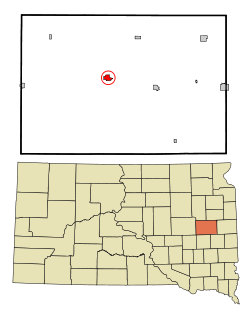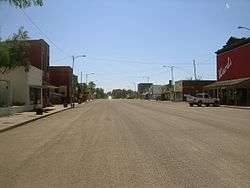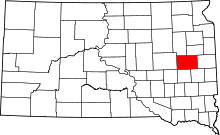De Smet, South Dakota
| De Smet, South Dakota | |
|---|---|
| City | |
|
Downtown De Smet, South Dakota | |
 Location in Kingsbury County and the state of South Dakota | |
| Coordinates: 44°23′9″N 97°33′6″W / 44.38583°N 97.55167°WCoordinates: 44°23′9″N 97°33′6″W / 44.38583°N 97.55167°W | |
| Country | United States |
| State | South Dakota |
| County | Kingsbury |
| Founded[1] | 1880 |
| Incorporated[2] | 1883 |
| Area[3] | |
| • Total | 1.16 sq mi (3.00 km2) |
| • Land | 1.16 sq mi (3.00 km2) |
| • Water | 0 sq mi (0 km2) |
| Elevation | 1,726 ft (526 m) |
| Population (2010)[4] | |
| • Total | 1,089 |
| • Estimate (2015)[5] | 1,072 |
| • Density | 938.8/sq mi (362.5/km2) |
| Time zone | Central (CST) (UTC-6) |
| • Summer (DST) | CDT (UTC-5) |
| ZIP code | 57231 |
| Area code(s) | 605 |
| FIPS code | 46-16260[6] |
| GNIS feature ID | 1265178[7] |
| Website | http://www.desmetsd.com/ |
De Smet is a city in and the county seat of Kingsbury County, South Dakota, United States.[8] The population was 1,089 at the 2010 census.
History
Located in the area of South Dakota known as East River (east of the Missouri River, which diagonally divides the state), De Smet was platted by European Americans in 1880.[9] It was named for Belgian Father Pierre De Smet,[10] a 19th-century Jesuit missionary who worked with Native Americans in the United States and its territories for most of his life. In the mid 1880s, prairie fires and failures of crops after a three-year period of drought caused many settlers to relocate their farms and homesteads to easier areas.[11] By 1917, De Smet was a cow town, with many trains passing through every day carrying cattle to market.[12]
Geography
De Smet is located at 44°23′9″N 97°33′6″W / 44.38583°N 97.55167°W (44.385871, -97.551703).[13]
According to the United States Census Bureau, the city has a total area of 1.16 square miles (3.00 km2), all of it land.[3]
De Smet has been assigned the ZIP code 57231 and the FIPS place code 16260.
Transportation
Transportation for De Smet is by road (U.S. 14, State Highway 25), by air (Wilder Field, 2 1/2 miles north of De Smet),, or by the freight-only Rapid City, Pierre and Eastern Railroad. One of the two highways running through De Smet is U.S. 14, in an east-west direction. The other is north-south South Dakota State Highway 25.
Demographics
| Historical population | |||
|---|---|---|---|
| Census | Pop. | %± | |
| 1880 | 116 | — | |
| 1890 | 541 | 366.4% | |
| 1900 | 749 | 38.4% | |
| 1910 | 1,063 | 41.9% | |
| 1920 | 1,035 | −2.6% | |
| 1930 | 1,017 | −1.7% | |
| 1940 | 1,016 | −0.1% | |
| 1950 | 1,180 | 16.1% | |
| 1960 | 1,324 | 12.2% | |
| 1970 | 1,336 | 0.9% | |
| 1980 | 1,237 | −7.4% | |
| 1990 | 1,172 | −5.3% | |
| 2000 | 1,164 | −0.7% | |
| 2010 | 1,089 | −6.4% | |
| Est. 2015 | 1,072 | [14] | −1.6% |
| U.S. Decennial Census[15] 2015 Estimate[5] | |||
2010 census
As of the census[4] of 2010, there were 1,089 people, 478 households, and 290 families residing in the city. The population density was 938.8 inhabitants per square mile (362.5/km2). There were 552 housing units at an average density of 475.9 per square mile (183.7/km2). The racial makeup of the city was 98.8% White, 0.1% African American, 0.6% Native American, 0.1% Asian, and 0.5% from two or more races. Hispanic or Latino of any race were 0.5% of the population.
There were 478 households of which 24.3% had children under the age of 18 living with them, 52.3% were married couples living together, 5.4% had a female householder with no husband present, 2.9% had a male householder with no wife present, and 39.3% were non-families. 35.6% of all households were made up of individuals and 22.6% had someone living alone who was 65 years of age or older. The average household size was 2.17 and the average family size was 2.83.
The median age in the city was 49.6 years. 22% of residents were under the age of 18; 4.1% were between the ages of 18 and 24; 17.9% were from 25 to 44; 26% were from 45 to 64; and 29.9% were 65 years of age or older. The gender makeup of the city was 47.2% male and 52.8% female.
2000 census
As of the census[6] of 2000, there were 1,164 people, 524 households, and 300 families residing in the city. The population density was 1,102.2 people per square mile (424.0/km²). There were 582 housing units at an average density of 551.1 per square mile (212.0/km²). The racial makeup of the city was 98.37% White, 0.95% Native American, 0.09% Asian, 0.09% from other races, and 0.52% from two or more races. Hispanic or Latino of any race were 0.69% of the population.
There were 524 households out of which 24.8% had children under the age of 18 living with them, 50.0% were married couples living together, 3.2% had a female householder with no husband present, and 42.7% were non-families. 39.3% of all households were made up of individuals and 24.2% had someone living alone who was 65 years of age or older. The average household size was 2.09 and the average family size was 2.80.
In the city the population was spread out with 20.8% under the age of 18, 6.0% from 18 to 24, 21.1% from 25 to 44, 20.8% from 45 to 64, and 31.3% who were 65 years of age or older. The median age was 47 years. For every 100 females there were 89.0 males. For every 100 females age 18 and over, there were 87.0 males.
As of 2000 the median income for a household in the city was $27,760, and the median income for a family was $41,989. Males had a median income of $24,722 versus $20,417 for females. The per capita income for the city was $15,372. About 7.3% of families and 11.1% of the population were below the poverty line, including 7.1% of those under age 18 and 18.3% of those age 65 or over.
Notable people
De Smet was the childhood home of children's book author Laura Ingalls Wilder; the birthplace of her daughter Rose, who became an author known as Rose Wilder Lane; and the childhood home of supercentenarian Walter Breuning. Artist-illustrator Harvey Dunn was born in 1884 approximately eight miles from De Smet near Manchester, and painted scenes of frontier life in his later years.
Attractions

Since 1971, De Smet has hosted a pageant, held over several weekends in July, to honor Laura Ingalls Wilder. Five of her classic Little House books were based on her experiences in and around the community. The books were popularized anew in the 1970s and early 1980s, from the long-running TV series Little House on the Prairie, which was loosely based on them.
The story of how Charles Ingalls and his wife Caroline arrived in De Smet in 1879 by covered wagon from Walnut Grove, Minnesota, is told by a cast of thirty in an open-air theater near the old Ingalls homestead and the Surveyors' House. Nearby are Silver Lake and the Big Slough, locales mentioned in her books. Reminders of De Smet's pioneer past are evident throughout the town, including the First Congregational Church, where the Ingallses worshipped.
In 1894 Laura and her husband Almanzo Wilder, with their daughter Rose left De Smet to live on a farm in the Ozarks near Mansfield, Missouri. There Laura Ingalls chronicled her South Dakota memories in such works as The Long Winter, Little Town on the Prairie, and These Happy Golden Years. Many residents in De Smet have made a special effort to learn the Ingalls' stories in hopes of assisting inquiring tourists each summer.[16]
References
- ↑ Federal Writers' Project (1940). South Dakota Place-Names, Part I: State, County, and Town Names. Vermillion, South Dakota: University of South Dakota. p. 34. OCLC 34885177.
- ↑ "SD Towns" (PDF). South Dakota State Historical Society. Retrieved 2010-02-11.
- 1 2 "US Gazetteer files 2010". United States Census Bureau. Retrieved 2012-06-21.
- 1 2 "American FactFinder". United States Census Bureau. Retrieved 2012-06-21.
- 1 2 "Population Estimates". United States Census Bureau. Retrieved June 7, 2016.
- 1 2 "American FactFinder". United States Census Bureau. Retrieved 2008-01-31.
- ↑ "US Board on Geographic Names". United States Geological Survey. 2007-10-25. Retrieved 2008-01-31.
- ↑ "Find a County". National Association of Counties. Retrieved 2011-06-07.
- ↑ Chicago and North Western Railway Company (1908). A History of the Origin of the Place Names Connected with the Chicago & North Western and Chicago, St. Paul, Minneapolis & Omaha Railways. p. 64.
- ↑ Gannett, Henry (1905). The Origin of Certain Place Names in the United States. Govt. Print. Off. p. 105.
- ↑ Samuel Clark, Sr., and his descendants. Second edition. By Rev. Edgar Warner Clark, A.M.. 1892. p. 99.
- ↑ Marian Cramer, :Cows on Parade", South Dakota Magazine, May/June 1990
- ↑ "US Gazetteer files: 2010, 2000, and 1990". United States Census Bureau. 2011-02-12. Retrieved 2011-04-23.
- ↑ "Annual Estimates of the Resident Population for Incorporated Places: April 1, 2010 to July 1, 2015". Retrieved July 2, 2016.
- ↑ United States Census Bureau. "Census of Population and Housing". Retrieved June 7, 2016.
- ↑ Chuck Cecil, "Little Town on the Prairie," American Profile, June 2006.
External links
- De Smet Chamber of Commerce
- Ingalls Homestead Website
- Laura Ingalls Wilder Memorial Society Website
- Laura Ingalls Wilder Pageant Website
- De Smet School District Website

